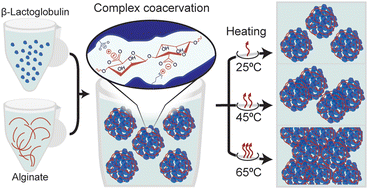Tuning alginate β-lactoglobulin complex coacervation by modulating pH and temperature†
Abstract
The use of biomolecules in food matrices and encapsulation systems is, as in other areas, moving towards greener solutions and a center piece here is the complex coacervation between natural anionic polysaccharides and proteins. Both alginate and β-lactoglobulin (β-Lg) are used in different sectors and have been shown to coacervate at pH < 5.2. Albeit with increased interest, complex coacervation has almost exclusively been studied from a macromolecular perspective, and described as an interaction based on charge–charge attraction. Here, we show that through changes in pH and temperature, alginate β-Lg complex coacervation can be tuned to purpose. By detailed biophysical and chemical characterization of coacervation and coacervate particles, insights into the molecular interaction and effect of external factors are obtained. We find that carboxylate resonance stabilization causes a release of protons at pH < pKa,alginate and an uptake of protons at pH > pKa,alginate upon coacervation. Proton release and uptake were quantified at pH 2.65 and 4.00 by isothermal titration calorimetry to be 4 and 2 protons per β-Lg molecule, respectively. By increasing the temperature to 65 °C, we discovered a secondary β-Lg concentration dependent coacervation step, where the formed particles change into large assemblies driven by entropy. These findings bring new insights to complex coacervation and its applicability in microencapsulation and drug delivery.



 Please wait while we load your content...
Please wait while we load your content...